Articles
| Name | Author | |
|---|---|---|
| Solutions In Practice: LOT Polish Airlines | Leszek Danielski, Flight Operations Engineer, LOT Polish Airlines | View article |
| Case Study: Southwest and United Airlines | Joe Nanini, Asst EFB Administrator, United Airlines, Amy Ashkinazy, EFB Manager, Southwest Airlines and Matt Swee, PIVOT | View article |
| White Paper: FAA EFB Policy Update | Brian Hint, Aviation Safety Inspector — Flight Technologies & Procedures Division at the FAA | View article |
| Case Study: Supporting key operational transformations at Alaska Airlines | Ryan Papineau Automated Test Engineer, Alaska Airlines, Jeff Crose, Software Development Engineer in Test, Alaska Airlines | View article |
Case Study: Southwest and United Airlines
Author: Joe Nanini, Asst EFB Administrator, United Airlines, Amy Ashkinazy, EFB Manager, Southwest Airlines and Matt Swee, PIVOT
Subscribe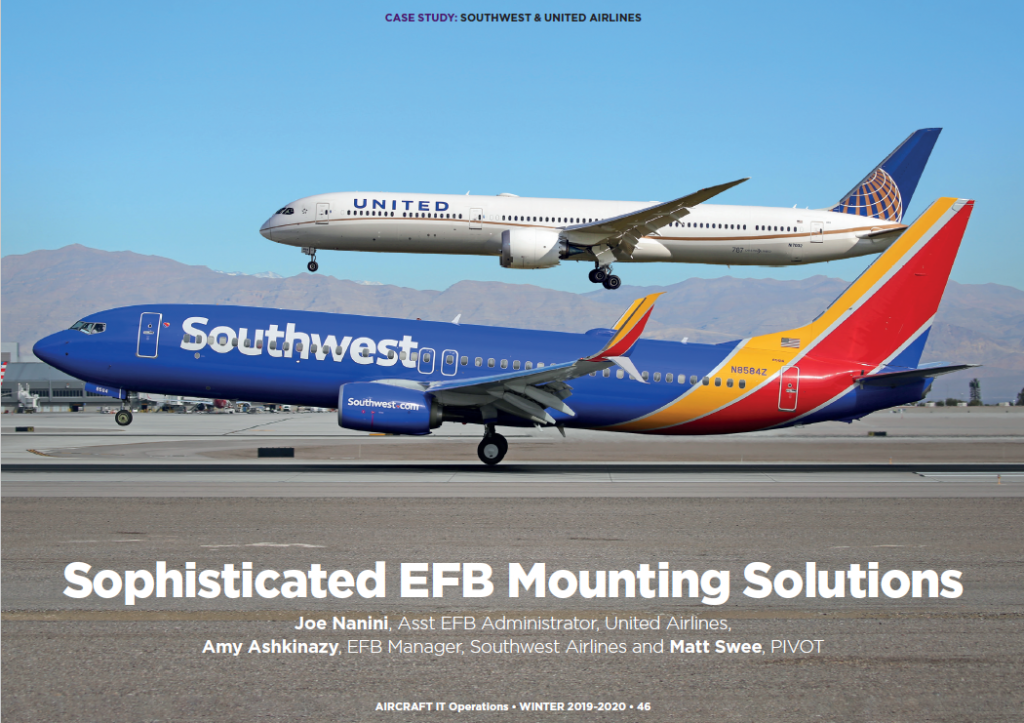
Joe Nanini, Asst EFB Administrator, United Airlines, Amy Ashkinazy, EFB Manager, Southwest Airlines and Matt Swee, PIVOT
Before we delve too far into how two major airlines have adopted and integrated the mounting system for their EFB devices, we thought it would be a good idea to familiarize readers with the object at the heart of this case study, the PIVOT mounting solution.
MOUNTING EFB DEVICES SAFELY, SECURELY AND ACCESSIBLY
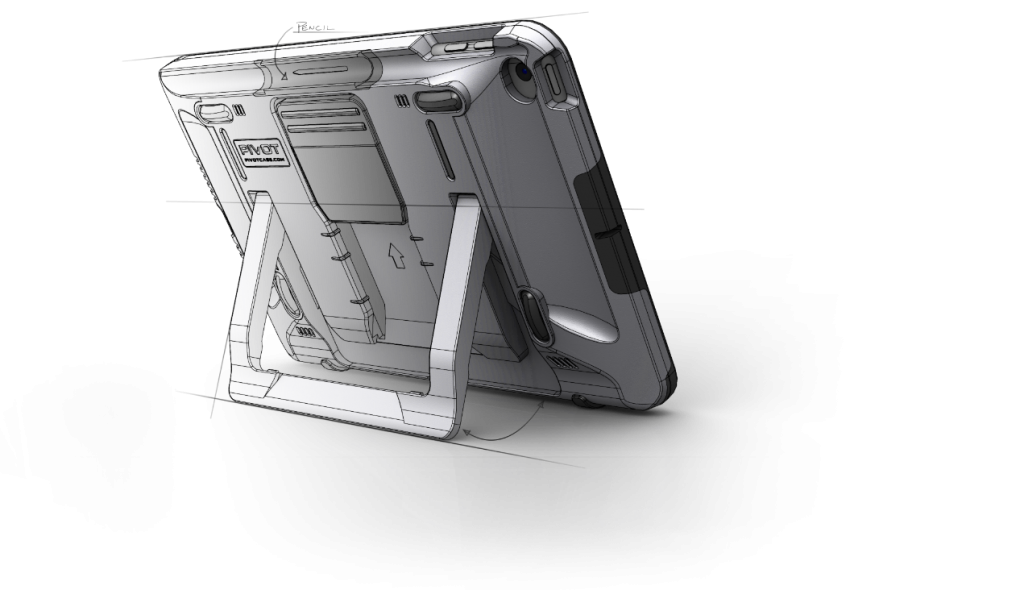
PIVOT started in 2013, at about the time when Apple was rapidly gaining market share in aviation and iPad usage was passing that of other tablets. As airline pilots themselves, the people at PIVOT recognized the need to streamline the way in which air crew and companies managed their EFB experiences. The goal was to develop a universal mounting method that could secure and protect a device while ensuring it could be utilized time and time again. Without this solution, bulky suction cups and cradles or expensive installed options would remain as the only mounting solution on the market.
Figure 1: PIVOT custom designs products to meet pilot’s needs in and out of the cockpit.
The challenge was placing a tablet device in the aircraft in such a way that it increased the capability of the crew without serving as a distraction. Also, from a business perspective, how could the mount device be integrated into the enterprise and business side of the organization? Part of that could be achieved with standardization across many different aircraft types, but also standardization of ways to mount EFBs as every aircraft is slightly different and each has its own set of requirements.

Figure 2: The original PIVOT iPad Air 1 case was designed in 2013 specifically for aviation use.
What began as a suction cup mount has transitioned over the years to include other options for mounting. Most importantly, PIVOT developed the Long-Term Removable Mount (LTRM™) which has permanently changed the industry. The LTRM™ is a patent-pending solution which is custom fit to each aircraft type. With virtually instant installation and indefinite lifespan, airlines opt for this solution as it provides STC mount performance at a fraction of the hardware or labor cost. For those users desiring installed mounts, PIVOT has many options with STC providers under license. The flexibility to choose the level of mounting, suction, LTRM™ or installed STC is a big part of the PIVOT solutions gains in the market.
Starting in 2014, Southwest Airlines was the first customer for PIVOT’s revolutionized mount. Shortly thereafter, United Airlines began using the PIVOT solution along with FedEx, WestJet and Jazz Airlines. Currently, over 140 airlines worldwide have adopted the PIVOT mount solution for EFB device installations, including Air Canada, Singapore Airlines, Cathay Pacific, ANA, Virgin Atlantic and Qantas.
This worldwide deployment has allowed the PIVOT team to interact with a wide spectrum of regulatory authorities, to understand the different ways in which airlines operate, to better understand pilot preferences and, from that, to refine a mounting solution that increases the capability of whatever tablet the airline chooses to use. Now, the mounting concept is being adopted in other non-cockpit settings with cabin mounting projects, flight line, as well as maintenance.
Today, there are more than 140,000 daily EFB users who have accumulated more than 120 million block hours across all types of mounts and device types. This broad user group has made it possible to recognize trends regarding how the devices need to be mounted as well as differences between North American users and European users. EASA and the FAA share similarities in their approaches and attitudes but there are also some differences. Fortunately for PIVOT, their mounts have all been regularly seen and accepted by both entities. Now, with adoption of the mounts growing fast in Asian markets, these regulators have become very familiar with the differences between suction cup mounts, LTRMs and STCs and how they integrate to into the pilot’s workflow.
THE EXPERIENCE AT UNITED AIRLINES
Joe Nanini, a First Officer with United Airlines, joined the airline’s EFB team in 2017 at a time when the airline was undertaking an EFB refresh to the iPad Pro 10.5. United had introduced the pilot issued iPad in 2011, starting with the fourth Generation iPad. United’s devices are cellular enabled with a PIVOT case for more than 775 aircraft in the United fleet. There are 12,700 pilots in United with new hiring running at about 40 every two weeks. For this group, the airline has some 13,500 iPads including spares and loaners. This is all controlled under Flight Operations and the EFB team focuses on the EFB — they don’t control the in-flight tool.
At United, the more than 775 aircraft in the fleet represent six different aircraft types with several sub-fleets below that. In any given week, United has approximately 25 to 30 pilots who change fleet, so the airline wanted a cost-efficient way to protect and mount the iPad which PIVOT can provide.
United uses just one make and model of EFB, currently the iPad Pro 10.5 and previously the iPad Air 2, but with Apple’s regular changes of technology, supplies of any given model begin to dwindle. United runs about a three-year cycle which has meant they must continually plan ahead for the next device. While Apple guarantees battery life cycles for about a thousand recharges, a pilot who charges their iPad every day should achieve the three-year lifespan for the EFB. A critical feature of the PIVOT cases is that each successive EFB device which is adopted, no matter the form factor, will be able to connect to the aircraft mounts without any change to the mount device. This allows a large airline like United to save money and labor by seamlessly ‘rolling-in’ a new device.
THE EXPERIENCE AT SOUTHWEST AIRLINES
Southwest has a single type fleet of 750 Boeing 737s. The airline has 10,000 pilots and 11 crew bases, each of which holds five spare devices and five loaner devices. Six years ago, Southwest chose the PIVOT suction cup mount. The ability to use a simple but effective mount initially allowed them to focus on the EFB program and to take their time evaluating the wide variety of installed mounts on the market. Once again, it mattered that regardless of what device was used, there would never be a need to change the mount. Many Southwest aircraft still used the suction cup mount at the time of writing. The airline was switching to the STC mount but it’s a slow process — some of the airline’s suction cup mounts have been in place for five years. Southwest has refreshed their EFB’s once during this period and report it was a smooth transition. When they first started the EFB program in 2013, other airlines warned them to expect a 4-10% annual break rate of their iPads. However, using the PIVOT case, breakages have been under one percent annually and under a half percent for the entire period.

Figure 3: EFB in action using the PIVOT universal suction cup mount and case. Photo Courtesy: Southwest Airlines.
In the first quarter of 2020, Southwest will be undertaking a refresh to the third iPad type used which will be fitted with a PIVOT case. Plus, the almost 20,000 flight attendants in the airline’s cabin crews also have a PIVOT case on their devices and their credit card reader is custom fit to go over the PIVOT case. Southwest’s EFB team includes three people with two project pilots. The team is one hundred percent responsible for pilots but also assists with the cabin crew devices, plus maintenance. Anyone at Southwest who’s implementing an iPad project goes to the EFB team for help.
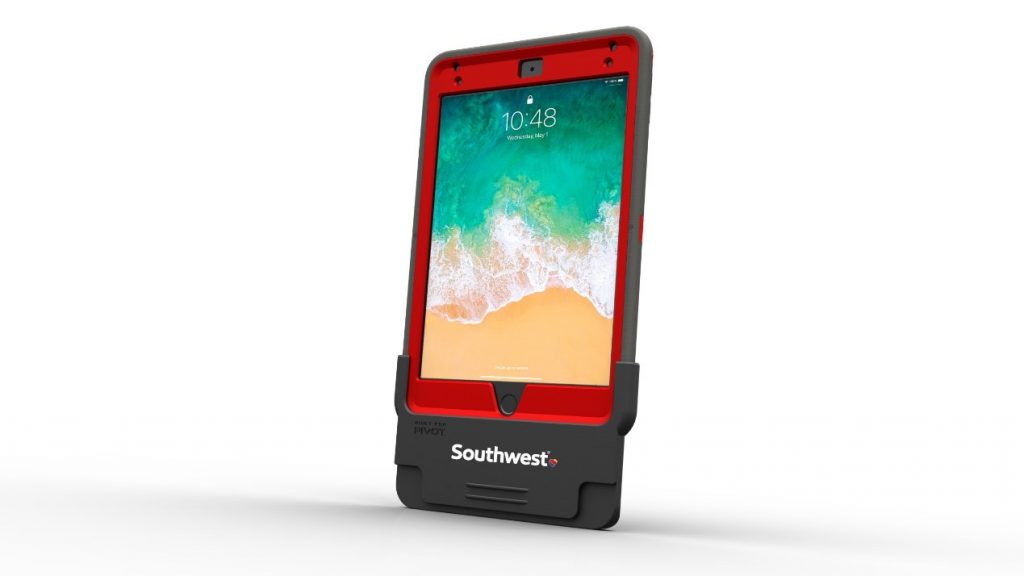
Figure 4: Southwest Airlines’ cabin crews also have the PIVOT case on their devices. A custom fit credit card reader was designed to go over the PIVOT case.
Although the two airlines represented here are very different, both share information and can help each other. Users have noticed that iPads that have been fitted with PIVOT mounts enable the airline to get the best possible price when the devices are refurbished and sold as the PIVOT cases do an excellent job of preserving the original finish of the iPad and many times come out looking like new after three years.
STC MOUNTS
As we’ve already noted, both United and Southwest are moving towards an STC mount for the future but not all aircraft are suited to that type of mount. For Southwest, everything will go to an STC mount eventually. The change-over process is slow, but the suction cups are holding up extremely well with hardly any releases and the FAA has been pleased with the use of the mount in the airline’s aircraft.
Similarly, at United, the change to STC mounts is slow. All Airbus A319 and A320 aircraft have STC fixed mounting solutions with the PIVOT attachment and the airline is working with the Boeing 737 fleet as well as the other Boeing types in service. Like Southwest, United continues to use suction cup mounts as they have found them to be very reliable. However, United will be testing the LTRM™ solution for B737s. For Southwest, the combination of the ASG and the PIVOT mount is effective.
PIVOT has worked with STC partners like Airbus, navAero, ASG and others to develop the ultimate solution once an airline is ready to invest in a permanent installation for their fleet. However, the suction cup mount allows an airline to start to establish standardization and build into a phased approach — if an STC is the goal years into the future, there has already been a start. And, in many instances, the suction or LTRM™ is preferred for aircraft under lease as there are no costs associated with de-modification at the end of the term.
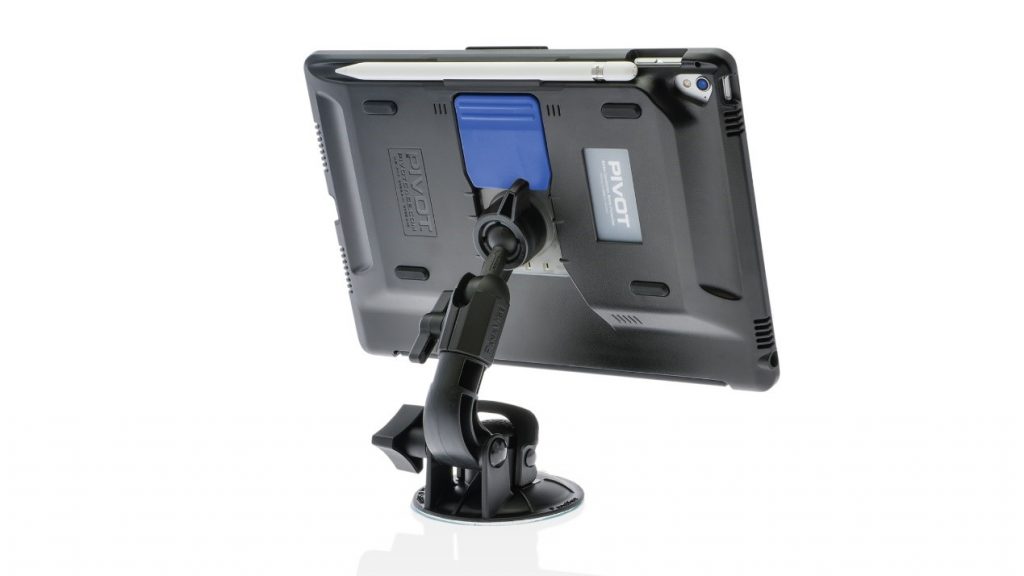
Figure 5: PIVOT offers a variety of EFB mounts, including the PIVOT 809 suction cup mount. Reviewed and approved by the FAA, this mount enables airlines to commence EFB operations while vetting STCs.
REGULATORS AND EFB MOUNTING
An issue that often arises in Europe and in Asia is the durability of the suction cup solution and how to reassure regulators that it will not impact flight controls and will be placed properly.
When Southwest did their initial test, there were 750 pilots who used their own iPad and each of those testers was issued with a suction cup mount. During the testing phase, they were asked to report on the pros and cons of the solution. There were no unintended releases reported in the six-month test phase. Over the airline’s first three years, there were only a few unintentional releases which are a testament to the quality of the PIVOT mount.
The FAA has designated two categories, installed and portable devices, that allow for suction cup and LTRM™ used in the phased approach we’ve already mentioned. Upon introduction to the fleet, crews can be trained over time. While the end goal may be the STC, now there is no hurry to decide. The important part is to future-proof the operation against device changes. If Apple comes up with an entirely new device or the airline selects a different device at some point in the future, PIVOT allows users to deal efficiently with the regulators on a known solution which they have worked with in the past.
EFB PROGRAMS
One major facet of any EFB program includes choosing the device the airline wants — iPad, Surface or other tablet. Given this is a huge capital investment, it is always a big decision. Since PIVOT makes protective cases for all the main EFB devices, airlines can pick the best solution for their operation and not just what fits their cradle.
The next concern is what goes in the EFB. For Southwest, the EFB apps are third-party vendor apps. However, the airline realized that it had to become current with the latest in mobile technology. Also the airline didn’t have an efficient way for crews to check in for their flights outside of the airport — the airline’s flight attendants had to line up to use a phone at the airport to check in.
Southwest collaborated with a company called LexTech and built what started out as a check-in app on which all the pilots and flight attendants could see their trip and check in for it. Since then, it has progressed to enable them to view their schedule, check in for trips if they have a dead head in the trip, pull up the boarding pass and use it to pre-board on the aircraft, view their sick bank and more. Right now, the app is on the EFB — the next step has been to deploy the app to a personal phone. The biggest issue is that Southwest’s technology department wanted every pilot and flight attendant to enroll their personal phone into the airline’s device management software, Airwatch. The team did not feel comfortable with that, so the tech department is working on another option.
Many of United’s EFB applications are third-party. For flight planning and scheduling, the airline is using a desk-top program called CCS but has moved to an internal in-house application called Pilot Mobile. Pilot Mobile pulls feeds from different areas in CCS so that crew can sign up as fit for duty, complete flight plan release pulls, see who the crew is on a flight and more. However, it’s really just the presentation of information. That’s also what United uses for compliance and reading of documents such as Operations Bulletins and Pilot Bulletins. As far as other EFB applications are concerned, as with Southwest, United’s applications are all third-party, some of which the airline is working to integrate into a one-stop-shop solution. The EFB route being followed by all airlines today will provide customer specific feeds from the various vendors tailored to what the airline wants them to look like. A perk to this is that if an airline does change a vendor, to the end user it makes no difference because the front view always looks the same regardless of what changes on the back-end.
At the time of writing, United did still have ship sets for charting in the aircraft and was working towards getting rid of those so that going paperless with one application will help to achieve standardization with all fleet types, will be weight-saving and will bring added benefits.
Contributor’s Details
Joe Nanini

After flight instructing and over a decade working for a regional carrier, Joe joined United Airlines as a 757/767 First Officer. He also works as a special assignment pilot and project manager on United’s EFB team where he oversees several flight operations projects and tests new applications for pilots.
Amy Ashkinazy-Murrell
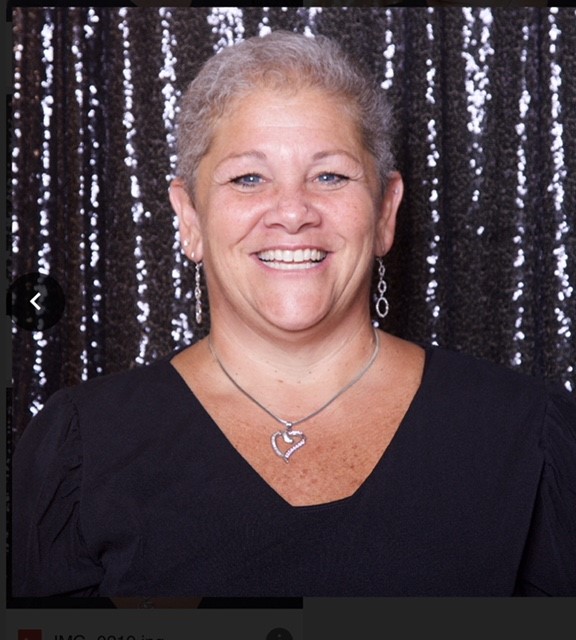
Amy Ashkinazy-Murrell is the EFB Manager at Southwest Airlines. In total, Amy and her staff manage a combined total of 30,000 devices. Amy’s aviation background spans a total of 37 years. She is well known throughout the EFB community for her wide ranging expertise and willingness to help others.
Matt Swee, PIVOT

Southwest Airlines

Southwest Airlines Co. is a major American airline headquartered in Dallas, Texas, and is the world’s largest low-cost carrier. With more than 59,000 employees, Southwest operates about 4,000 departures a day during peak travel season. Southwest is the largest operator of the Boeing 737 worldwide, with 753 in service.
United Airlines

United Airlines, Inc. is a major American airline headquartered in Chicago, Illinois. and operating a large domestic and international route network. Regional service is operated by independent carriers under the brand name United Express. As of March 2019, United Airlines operated a fleet of 778 aircraft; all Boeing and Airbus.
Pivot

PIVOT supplies a device case and mounting solution to secure EFB devices in the cockpit with a unique integrated mounting channel that creates a constant future-proof assurance – no matter what the next device might be. Because the people behind Pivot are pilots, the system has been created with understanding of the task.
Comments (0)
There are currently no comments about this article.

To post a comment, please login or subscribe.